From CatholicCulture.org;
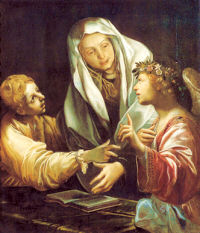
Daily Readings for:March 09, 2012
Move to: Previous Day | Next Day
Today's Gospel is often used by Protestants to challenge the Catholic practice of calling our priests "Father." Learn how to defend this practice — begin by reading Art Kelly's apologetics article, Call No Man Father?. Discuss this custom and the reasoning behind it with your children.
Invoke St. Frances' protection as you are getting in your car to drive somewhere today.
St. Frances was certain that she had a vocation to the religious life from the age of eleven. However, her father forced her to marry, and so she instead joyfully loved and served her husband until his death enabled her to enter the religious life when she was fifty-two years old. Even when you may have certainty that God is calling you to walk a certain path, His timing may be different from your own. Reflect on your own vocation: regardless of any doubts you may have, or seemingly unfulfilled desires to do more for God, abandon yourself to His will of the present moment, and joyfully focus on fulfilling the small duties which your vocation asks of you. Read about sanctification through the present moment in Rev. Jean-Pierre de Caussade's excellent little work, Abandonment to Divine Providence (online version).
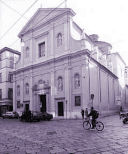
The most comprehensive treatment of the Liturgical Year available online: daily reflections, saints, seasons, calendars, prayers, activities, and recipes.

Daily Readings for:March 09, 2012
(Readings on USCCB website)
Collect: O God, who have given us in Saint Frances of Rome a singular model of both married and monastic life, grant us perseverance in your service, that in every circumstance of life we may see and follow you. Through our Lord Jesus Christ, your Son, who lives and reigns with you in the unity of the Holy Spirit, one God, for ever and ever.
- None
- Lent Table Blessing 2
- Roman Ritual Blessing Before and After Meals: Lent (2nd Plan)
- Novena Prayer in Honor of St. John Ogilvie
- Prayer to Saint Dominic Savio
- None
RECIPES
ACTIVITIES
PRAYERS
LIBRARY
Lent: March 9th

 Optional Memorial of St. Frances of Rome, religious; Feast of St. John Ogilvie, priest and martyr (Scotland)Old Calendar: St. Frances of Rome; St. Dominic Savio (Historical)
Optional Memorial of St. Frances of Rome, religious; Feast of St. John Ogilvie, priest and martyr (Scotland)Old Calendar: St. Frances of Rome; St. Dominic Savio (Historical)
Move to: Previous Day | Next Day"I give you a new commandment: Love one another as I have loved you, says the Lord (Jn 13:34)." In the fifteenth century St. Frances, among the noble ladies of Rome, showed herself an example of what a Christian wife should be. After the death of her husband she retired from the world and lived in a monastery of Oblates that she had founded under the Rule of St. Benedict. God favored her with the visible presence of her guardian angel with whom she conversed familiarly.
Today Catholics in Scotland celebrate the Feast of Blessed John Ogilvie, who was educated as a Calvinist and was received into the Church at Louvain by Father Cornelius a Lapide. After becoming a Jesuit at the age of seventeen, he was ordained to the priesthood in 1613, and at his own request was sent on a perilous Scottish mission. He was eventually betrayed, but during a long imprisonment no tortures could force him to name any fellow Catholics. Though his courage was admired by the judges he was condemned as a traitor and hanged at Glasgow. The customary beheading and quartering were omitted owing to undisguised popular sympathy, and his body was hurriedly buried in the churchyard of Glasgow cathedral.
St. Frances of Rome
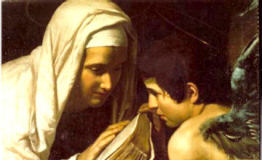 St. Frances of Rome founded the institute known as the "Oblati di Tor de Specchi" in the Holy City. She was a wealthy patrician and after her husband died, she gave up all her wealth to live a life of abject poverty. Her special privilege from heaven was familiar conversation with her guardian angel. Reading the life of St. Frances, one gains the impression that she moved and lived in the spiritual world more than on earth; in fact, that which gives her life its unique character is her intimate relationship with the blessed world of holy spirits.
St. Frances of Rome founded the institute known as the "Oblati di Tor de Specchi" in the Holy City. She was a wealthy patrician and after her husband died, she gave up all her wealth to live a life of abject poverty. Her special privilege from heaven was familiar conversation with her guardian angel. Reading the life of St. Frances, one gains the impression that she moved and lived in the spiritual world more than on earth; in fact, that which gives her life its unique character is her intimate relationship with the blessed world of holy spirits.
 St. Frances of Rome founded the institute known as the "Oblati di Tor de Specchi" in the Holy City. She was a wealthy patrician and after her husband died, she gave up all her wealth to live a life of abject poverty. Her special privilege from heaven was familiar conversation with her guardian angel. Reading the life of St. Frances, one gains the impression that she moved and lived in the spiritual world more than on earth; in fact, that which gives her life its unique character is her intimate relationship with the blessed world of holy spirits.
St. Frances of Rome founded the institute known as the "Oblati di Tor de Specchi" in the Holy City. She was a wealthy patrician and after her husband died, she gave up all her wealth to live a life of abject poverty. Her special privilege from heaven was familiar conversation with her guardian angel. Reading the life of St. Frances, one gains the impression that she moved and lived in the spiritual world more than on earth; in fact, that which gives her life its unique character is her intimate relationship with the blessed world of holy spirits.During the three periods of her life, three angels of different rank accompanied her, ready to protect her soul against any onslaught of hell and to lead her step by step to spiritual perfection. Day and night the saint saw her angel busy at a mysterious task. With three little golden spindles he unceasingly spun golden threads, strung them around his neck, and diligently wound them into balls. A half year before her death he changed his work. Instead of spinning more golden thread, he began to weave three carpets of varying size with the golden thread he had spun. These carpets symbolized her lifework as virgin, mother, and religious.
Shortly before her death, she noticed how the angel was hurrying his work, and his face was unusually fresh and happy. At the very moment when the last carpet had reached its required length, her soul departed into eternal bliss.
Excerpted from The Church's Year of Grace, Pius Parsch
Patron: automobile drivers, automobilists, cab or taxi drivers, death of children, lay people, motorists, people ridiculed for their piety, Roman housewives, widows.
Symbols: often depicted as a woman habited in black with a white veil, accompanied by her guardian angel, and sometimes carrying a basket of food; Nun with her guardian angel dressed as a deacon. Monstrance and arrow; book; angel with a branch of oranges; receiving the veil from the Christ Child in the arms of the Blessed Virgin.
Things to Do:
Bl. John Ogilvie
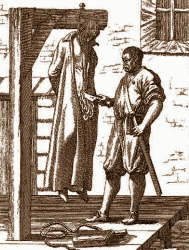 Born in 1579 at Drum, Keith, Scotland. Walter Ogilvie was a Scottish noble who raised his son John in the state religion of Scotland, Calvinism. John converted to Catholicism at the age of 17 in Louvain, Belgium. Blessed John joined the Jesuits soon after in 1597, and was ordained in Paris in 1610. He was sent to work in Rouen, France.
Born in 1579 at Drum, Keith, Scotland. Walter Ogilvie was a Scottish noble who raised his son John in the state religion of Scotland, Calvinism. John converted to Catholicism at the age of 17 in Louvain, Belgium. Blessed John joined the Jesuits soon after in 1597, and was ordained in Paris in 1610. He was sent to work in Rouen, France.
 Born in 1579 at Drum, Keith, Scotland. Walter Ogilvie was a Scottish noble who raised his son John in the state religion of Scotland, Calvinism. John converted to Catholicism at the age of 17 in Louvain, Belgium. Blessed John joined the Jesuits soon after in 1597, and was ordained in Paris in 1610. He was sent to work in Rouen, France.
Born in 1579 at Drum, Keith, Scotland. Walter Ogilvie was a Scottish noble who raised his son John in the state religion of Scotland, Calvinism. John converted to Catholicism at the age of 17 in Louvain, Belgium. Blessed John joined the Jesuits soon after in 1597, and was ordained in Paris in 1610. He was sent to work in Rouen, France.He repeatedly requested assignment to Scotland where wholesale massacres of Catholics had taken place, but by this point the hunters were searching more for priests than for those who attended Mass.
The Jesuits were determined to minister to the oppressed Catholic laity. When captured, they were tortured for information, then hanged, drawn, and quartered.
Ogilvie's request was granted, and he returned to Scotland in November 1613. He worked as an underground missionary in Edinburgh and Glasgow, dodging the Queen's priest-hunters, disguising himself as a soldier named Watson. After 11 months in the field, John was betrayed, imprisoned, interrogated, then tortured for the names of active Catholics. He suffered in silence.
He is the Church's only officially recorded Scottish martyr. He died hanged on March 10, 1615 in Glasgow, Scotland and was canonized by Paul VI on October 17, 1976.
Things to Do:
- Read more about the life of Bl. John Ogilvie.
St. Dominic Savio
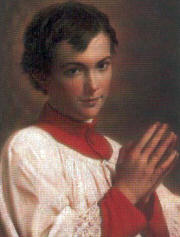 Here was a boy-saint who died at the age of fifteen, was one of the great hopes of St. John Bosco for the future of his congregation, and was canonized in 1954.
Here was a boy-saint who died at the age of fifteen, was one of the great hopes of St. John Bosco for the future of his congregation, and was canonized in 1954.
 Here was a boy-saint who died at the age of fifteen, was one of the great hopes of St. John Bosco for the future of his congregation, and was canonized in 1954.
Here was a boy-saint who died at the age of fifteen, was one of the great hopes of St. John Bosco for the future of his congregation, and was canonized in 1954.He was one of ten children of Carlo and Birgitta Savio. Carlo was a blacksmith and Birgitta was a seamstress. When Don Bosco was looking for young men to train as priests for his Salesian Order, his parish priest suggested Dominic Savio. Dominic became more than a credit to Don Bosco's school—he single-handedly organized those who were to be the nucleus of Don Bosco's order.
St. Dominic Savio was twelve when he met Don Bosco and organized a group of boys into the Company of the Immaculate Conception. Besides its religious purpose, the boys swept and took care of the school and looked after the boys that no one seemed to pay any attention to. When, in 1859, Don Bosco chose the young men to be the first members of his congregation, all of them had been members of Dominic's Company.
For all that, Dominic was a normal, high-spirited boy who sometimes got into trouble with his teachers because he would often break out laughing. However, he was generally well disciplined and gradually gained the respect of the tougher boys in Don Bosco's school.
In other circumstances, Dominic might have become a little self-righteous snob, but Don Bosco showed him the heroism of the ordinary and the sanctity of common sense. "Religion must be about us as the air we breathe," Don Bosco would say, and Dominic Savio wore holiness like the clothes on his back.
He called his long hours of prayer "his distractions." In 1857, at the age of fifteen, he caught tuberculosis and was sent home to recover. On the evening of March 9, he asked his father to say the prayers for the dying. His face lit up with an intense joy and he said to his father: "I am seeing most wonderful things!" These were his last words.
— Excerpted from The One Year Book of Saints by Rev. Clifford Stevens
Patron: Boys; children's choirs; choir boys; choirs; falsely accused people; juvenile delinquents; Pueri Cantors.
Things to Do:
- Learn more about the Salesians and Salesian saints.

The Station for today is in the church of St. Vitalis, martyr, the father of the two illustrious Milanese martyrs, Sts. Gervasius and Protasius. It was built about 400, and consecrated by Pope Innocent I in 401/2. The dedication to St. Vitalis and his family was given in 412. The church has been rebuilt several times, of which the most comprehensive rebuilding was that of Pope Sixtus IV before the 1475 Jubilee. It was then granted to Clerics Regular.
No comments:
Post a Comment